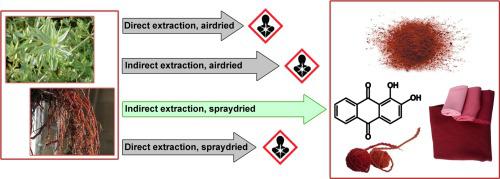Industrial Crops and Products ( IF 5.6 ) Pub Date : 2021-02-27 , DOI: 10.1016/j.indcrop.2021.113344 Goverdina C.H. Derksen , Frédérique L. van Holthoon , Hendra M. Willemen , Cyrille A.M. Krul , Maurice C.R. Franssen , Teris A. van Beek

|
Madder, used as a red dye, contains anthraquinones, and some of these can react with DNA possibly causing mutagenic effects. This is especially true for 1,3-dihydroxyanthraquinones with a hydroxymethyl (e.g., lucidin 6, ibericin 10) or methyl group (e.g., rubiadin 9) at C-2. In this research, a new process was developed through which the concentration of mutagenic compounds is minimized by adapting extraction and fractionation parameters. The process was tested on lab scale but also on 5000 L industrial scale. The first step is the key biotechnological step. Roots are stirred in water and the concentration of lucidin 6 is reduced to (near) zero by endogenous enzymes. When lucidin 6 is absent, the formation of mutagenic ibericin 10 by a reaction with ethanol as extraction solvent, is not possible. Mutagenicity can be further reduced by heat treatment, which is common in industrial downstream processing, e.g., in spray drying. Removal of rubiadin 9 is possible by flash chromatography. All madder root fractions were tested in the Salmonella microsome assay (Ames test, TA100) for mutagenicity, which was correlated with the anthraquinone concentration.
中文翻译:

开发获得用于纺织染色的非致突变性茜草(茜草)提取物的方法
用作红色染料的Madder含有蒽醌,其中一些会与DNA反应,可能引起诱变作用。对于在C-2处具有羟甲基(例如,lucidin 6,ibericin 10)或甲基(例如,茜草素9)的1,3-二羟基蒽醌尤其如此。在这项研究中,开发了一种新方法,通过调整提取和分级分离参数,可使诱变化合物的浓度降至最低。该过程在实验室规模上进行了测试,但也在5000 L工业规模上进行了测试。第一步是关键的生物技术步骤。将根在水中搅拌,通过内源酶将lucidin 6的浓度降低至(接近)零。当透明素6如果不存在,则不可能通过与乙醇作为萃取溶剂的反应来形成诱变的ibericin 10。致突变性可通过热处理进一步降低,这在工业下游加工中很常见,例如在喷雾干燥中。通过快速色谱法可以去除茜草素9。在沙门氏菌微粒体试验(Ames试验,TA100)中测试了所有茜草根级分的致突变性,这与蒽醌浓度相关。











































 京公网安备 11010802027423号
京公网安备 11010802027423号